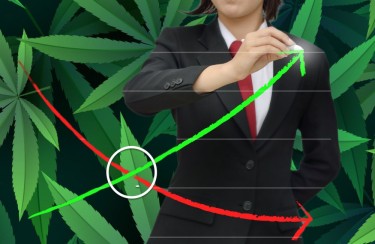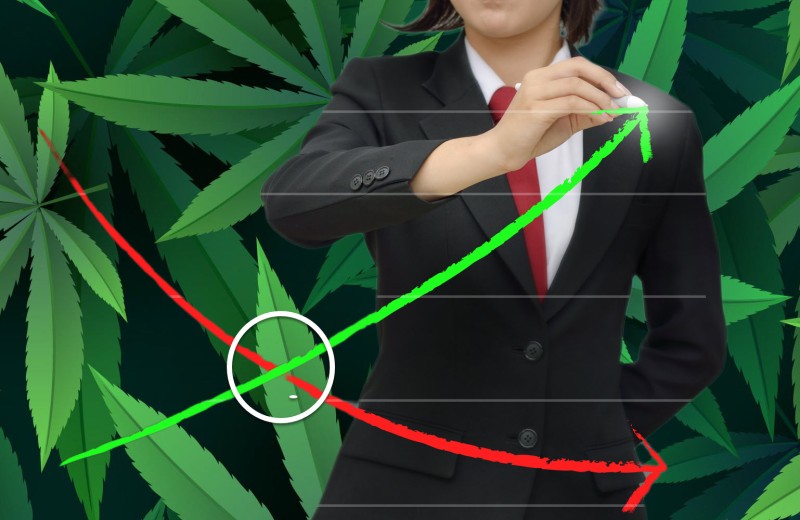
The struggles that California's cannabis companies have been grappling with have been no secret. Still, it wasn't until this year that a noticeable decline in the legal marijuana market started to unfold. According to permit statistics from the California Department of Cannabis Control, the market has shrunk by approximately 29%.
As of October 24, the state had only 9,900 active business licenses, marking a 28.5% decrease since July 2022, when there were 12,719 active provisional and annual cannabis business licenses, as reported by the DCC.
What Does the Stat Says
During the COVID-19 pandemic, the state's marijuana market exhibited robust growth, benefiting from stay-at-home orders and emergency financial assistance. In July 2021, the California Department of Cannabis Control (DCC) reported 11,335 active business licenses. Over the subsequent year, the market expanded by more than 12%.
The most significant changes were observed in the cultivation sector. In July 2021, there were 7,897 active marijuana cultivation permits, which increased to 8,453 within a year but subsequently dropped to 5,727 as of October 24 this year.
The manufacturing and distribution sectors also experienced substantial fluctuations. In July 2021, there were 877 cannabis manufacturers, and this number grew to 911 over the next 12 months before decreasing to 768 this month. Among distributors, there were 1,168 in July 2021, 1,448 in July 2022, and only 1,297 this month.
However, not all sectors have experienced a similar level of decline. The retail, delivery, and microbusiness permit categories have steadily grown over the past two years. Nonetheless, industry insiders suggest that the opening of new stores has been counterbalancing the closure of many well-established shops in oversaturated cities.
Recent examples of closures include Liberty Cannabis-owned shops in both San Francisco and Los Angeles, as highlighted by marijuana consultant Hirsh Jain of Ananda Strategy. Additionally, several multistate operators, such as Florida-based Trulieve Cannabis Corp. and Arizona-based 4Front Ventures Corp., have exited the California market. This is due to the challenging market conditions, a move echoed by numerous smaller companies and brands.
Despite the challenging trends, retail storefront permits showed remarkable resilience. In July 2021, they numbered 774, then surged to 1,056 a year later, and as of this month, they have reached 1,229, according to the DCC.
Delivery licenses, on the other hand, were at 322 in July 2021, increased to 475 in July 2022, and have since stabilized at around 477. Microbusiness permits, which often include retail operations, were at 297 in July 2021, grew to 376 within a year, and currently stand at 402.
Struggles To Pay Tax
The California cannabis industry is teetering on the edge of what some are calling an "extinction event" as cannabis shops struggle to stay afloat, grappling with missed tax payments and drowning in millions of dollars of debt.
Debt troubles have haunted the industry for years, with a 2022 report estimating that the collective debt burden exceeded $600 million. Nevertheless, a recent alteration in tax regulations, which took effect this year, has prompted stakeholders to worry that the burgeoning debt crisis could potentially culminate in a severe disaster.
In reaction to these apprehensions, a San Francisco lawmaker proposed a bill in the state legislature to enforce stricter measures on cannabis businesses that cannot fulfill their debt responsibilities.
A significant shift in state law has shifted the responsibility for paying cannabis excise taxes from distributors to retailers. Historically, retailers have faced the most challenges in meeting their financial obligations, and recent state tax data obtained by SFGATE indicates that many shops lack the necessary funds to cover their state excise taxes.
More than 13% of California's retailers, equivalent to 265 cannabis dispensaries, did not remit any tax payments, as reported by the California Department of Tax and Fee Administration. These businesses are now confronting a 50% penalty on their outstanding tax obligations, a financial blow that could prove fatal for many shops.
Furthermore, the number of affected shops could potentially increase. The state agency has revealed that it is still handling 581 tax returns, which may include retailers that failed to meet their payment obligations.
According to Michelle Mabugat, a cannabis attorney at the Greenberg Glusker firm in Los Angeles, the debt-related challenges are likely to force the closure of numerous shops in the state. She remarked that there's been a mounting debt bubble over the past few years, reaching a breaking point. She anticipates many retailers going out of business this year, much like we witnessed with cultivators last year."
Ali Jamalian, the owner of Sunset Connect, a cannabis manufacturer based in San Francisco, has observed pot shops with outstanding bills exceeding $500,000. He foresees the new tax structure triggering what he terms an "extinction event" for cannabis retailers in the state.
The persistent issue of debt has plagued the entire cannabis supply chain. Farmers have voiced concerns about not receiving payment for significant amounts of their products. Distributors have raised issues about non-payment by retailers and have resorted to blacklisting certain shops.
Furthermore, even the federal government has encountered payment issues. An analysis conducted last autumn by Green Market Report revealed that the ten largest cannabis companies in the country collectively owed over $500 million in unpaid taxes.
These financially strained retailers are now facing the possibility of closure due to the recent alteration in the state's tax payment process. The state's decision to transfer the responsibility for tax payments from distributors to retailers not only eliminated a source of financing (as retailers had been using excise tax collections to fund their operations) but also imposed a substantial penalty on cash-strapped retailers.
Conclusion
The California cannabis industry has faced significant challenges, with a 29% decline in active business licenses since July 2022. Despite growth during the COVID-19 pandemic, the cultivation sector saw fluctuations, and some multistate operators left the market due to its difficulty. However, the retail, delivery, and microbusiness sectors continued to grow, partly thanks to new store openings.
The shift in tax legislation, placing a heavier burden on retailers for paying excise taxes, has further strained the industry, with many retailers failing to meet their obligations. The industry's future hinges on its ability to adapt to changing market conditions and proposed legislative solutions.






